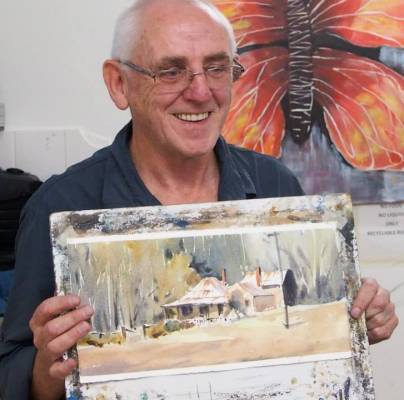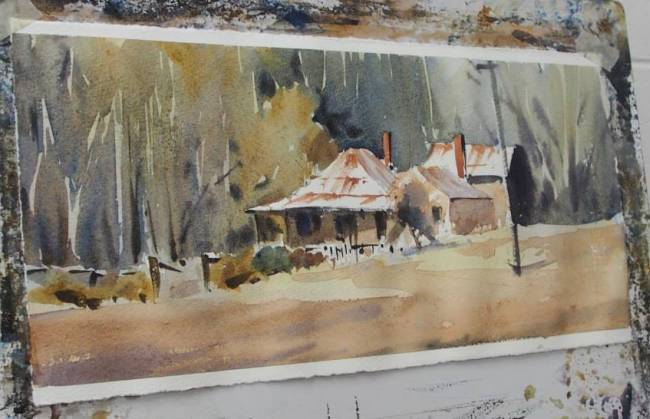Ted Dansey Demonstration, Saturday 18th April 2015
Watercolour Landscapes
 Ted
Dansey was a down-to-earth personality. He had a wry, self-deprecating
humour (often at the expense of his wife) which brought gusts of laughter
from the large, attentive audience. He is an ex-illustrator and graphic
designer who has turned to watercolour painting and teaching. One of his
influences was David Taylor about whom he speaks with some reverence. Ted
teaches at Vic Arts Society and has had exhibitions there.
Ted
Dansey was a down-to-earth personality. He had a wry, self-deprecating
humour (often at the expense of his wife) which brought gusts of laughter
from the large, attentive audience. He is an ex-illustrator and graphic
designer who has turned to watercolour painting and teaching. One of his
influences was David Taylor about whom he speaks with some reverence. Ted
teaches at Vic Arts Society and has had exhibitions there.
His subject today was how to use your travels to turn out lovely watercolour paintings. The first stage is to work small in a sketchbook and later on, in the studio, to use the sketches and photos you have taken yourself as references for larger paintings.
Before setting out, equip yourself with a simple set of gear. Nothing elaborate, because in a place with people around and an awkward sitting or standing position, fancy gear or too much gear can be frustrating. A smallish sketchbook, a good pen, not much else. He recommended a Faber Castell Pit pen in sepia colour, permanent ink. If you plan to use colour get a tiny portable set of watercolour pans with open-out mixing lids and a water bottle. Keep it simple. You have to be attracted to the subject to produce a re-usable sketch. Draw it well. The better the drawing the better the final painting will be because you will know more about it having observed it carefully to sketch it.
Photos you take yourself are good but they have too much detail, you will do better with sketches because they will have a focus on what you personally noticed. So, for Ted it was down to work from a sketch on to a larger piece of good paper. A pencil drawing first, then concentrate on the wash. He allows the colours to mix on the paper. Allow a little drying time. (I have noticed that good watercolour teachers have a stock of interesting stuff to say to fill in time while their wash is drying. Very smart.)
Then he puts in more detail. He is confident to put in quite dense darks behind the tree trunks, which remain white. The darkest darks behind or beside the lightest lights, a good rule to follow. Don't lose your lights by washing over them in the early stage. You can get them back to some extent but not fully. Watercolour painting is negative painting. You have to be aware of the negative spaces. Work on what is behind the subject to make it stand out.
His finished painting was a very beautiful country scene which brought great applause from the watchers.
Thank you so much Ted.

Ted's finished work
Report by Colin Browne